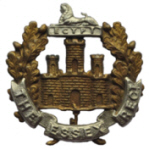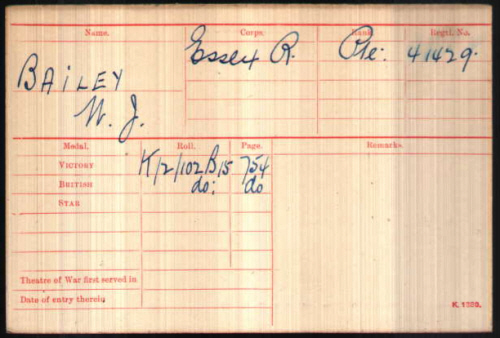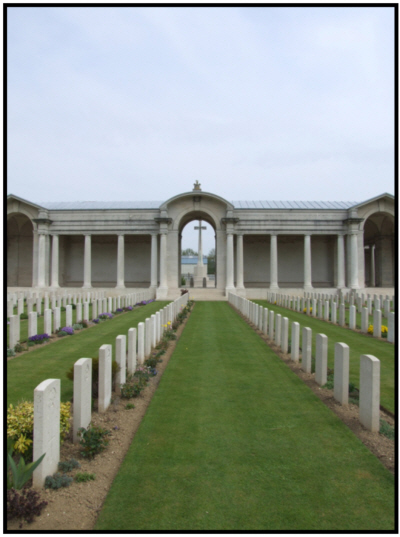



No.41429, Private, Walter John BAILEY
Aged 33

|
Walter John Bailey was born in Cowlinge [Risbridge Q1-1884 4a:601] to John and Agnes BAILEY (née BANNISTER). 1891 census...Aged 7, he was at Hall Lodge, Hall Road, Cowlinge with his father John BAILEY [33], a farm labourer; his mother Agnes S. [32], and brother JephaThomas [5] and sister Laura Jane. [3]. All the family were born in Cowlinge. 1901 census...Aged 17, a cattle stock man at Sturmer Hall Estate, Sturmer with his father (now horse keeper); mother; brother Jeptha ( now a carter on farm), and sister Laura. He married Ellen Eliza SIZER [26-4-1884] from Sturmer in Q1-1911. 1911 census...Aged 27, an Ostler, he was at King Edward Road, Newmarket with his wife Ellen Eliza [26], born Sturmer. He was employed as an Ostler at the Crown Hotel. His parents were still in Sturmer, with his widower grandfather William Bannister [76] born Cowlinge. His first two children died soon after birth (Walter Noel 1911 and an un-named daughter in 1913) but they went on to have Leslie Francis [17-5-1914], Walter [26-6-1915] and Brenda [1916]. His widow, later married in 1924, William J PEACOCK and lived in Maltings Row, Sturmer His entry in "Our Exning Heroes" reads Bailey, Walter John "Born 1884 in Cowlinge. Educated in the local school. He was ostler at the Crown Hotel when war broke out, and joined up in 1916. He was only 6 months in training before he was sent to France. He was in the Oppy Wood attack near Arras, and met his death by a shell. |

|
He enlisted in Newmarket. From the War Diary of the 13th Essex:- "On April 27th the Battalion marched to assembly trenches beyond Bailleul for the purpose of attckingon the right of Oppy Village. The men were in excellent spirits. In addition to the usual habiliments of war, they carried chocolate and two cheese sandwiches, whilst a rum issue was also made. No hitch occurred on reaching the jumping off positions. Each Company was organised in three platoons, representing three waves each, each wave consisting of two lines -the first bombers and riflemen and the second Lewis gunners and rifle bombers. Moppers up for each wave formed up in rear of the second line. Carrying parties and garrisons for the strong points were placed in the rear of the last wave. The Highland Light Infantry and 17th Middlesex were on the left and the Royal Marines on the right. At 8.25 am on the 28th April the barrage commenced and eight minutes later the first wave crossed the enemy's front line trench, with the exception of the extreme right which was held up by uncut wire and lost heavily from machine gun fire in endeavouring to get through it. Touch was lost, too, with the Royal Marines, though contact was maintained with the 17th Middlesex on the immediate left of the Essex. The advance continued under the cover of the barrage to the eastern end of Oppy Wood, when a German bombing attack was made on the right flank, whilst under support of machine gun and rifle fire from Oppy Village, large numbers of the enemy advanced down the Sunken Road from Crucifix Lane. A company of the 1st KRR, in support, was ordered to move forward and form a defensive flank. but were unable to get beyond the British front line because of the destructive fire. Matters became critical. The 17th Middlesex were counter- attacked on the front and left flank, whilst numbers of the enemy, making their way through Oppy Wood, managed to get to their rear and re-occupy portions of their old front line. Messengers sent from Battalion Headquarters did not return and as the fighting continued, at 9 am the tropps were ordered to fall back and consolidate on the German front line. Small parties succeeded in detaching themselves but found the Germans also in the trench and were unable to cope with them. All the officers of the Battalion had become casualties, with the majority of the N.C.O.s, and the survivors were much disorganised and exhausted. Small parties held out doggedly and were able at eventide to return to the old British front line by running from shell hole to shell hole." At roll call, casualties were heavy, 7 officers killed, 3 missing and 4 wounded. Other ranks were 3 killed, 79 wounded and 240 missing. In the event, CWGC records that 126 had died, and only 4 of these have known graves. |

photo: Commonwealth War Graves Commission
click here to go to the Commonwealth War Graves Commission website for full cemetery/memorial details